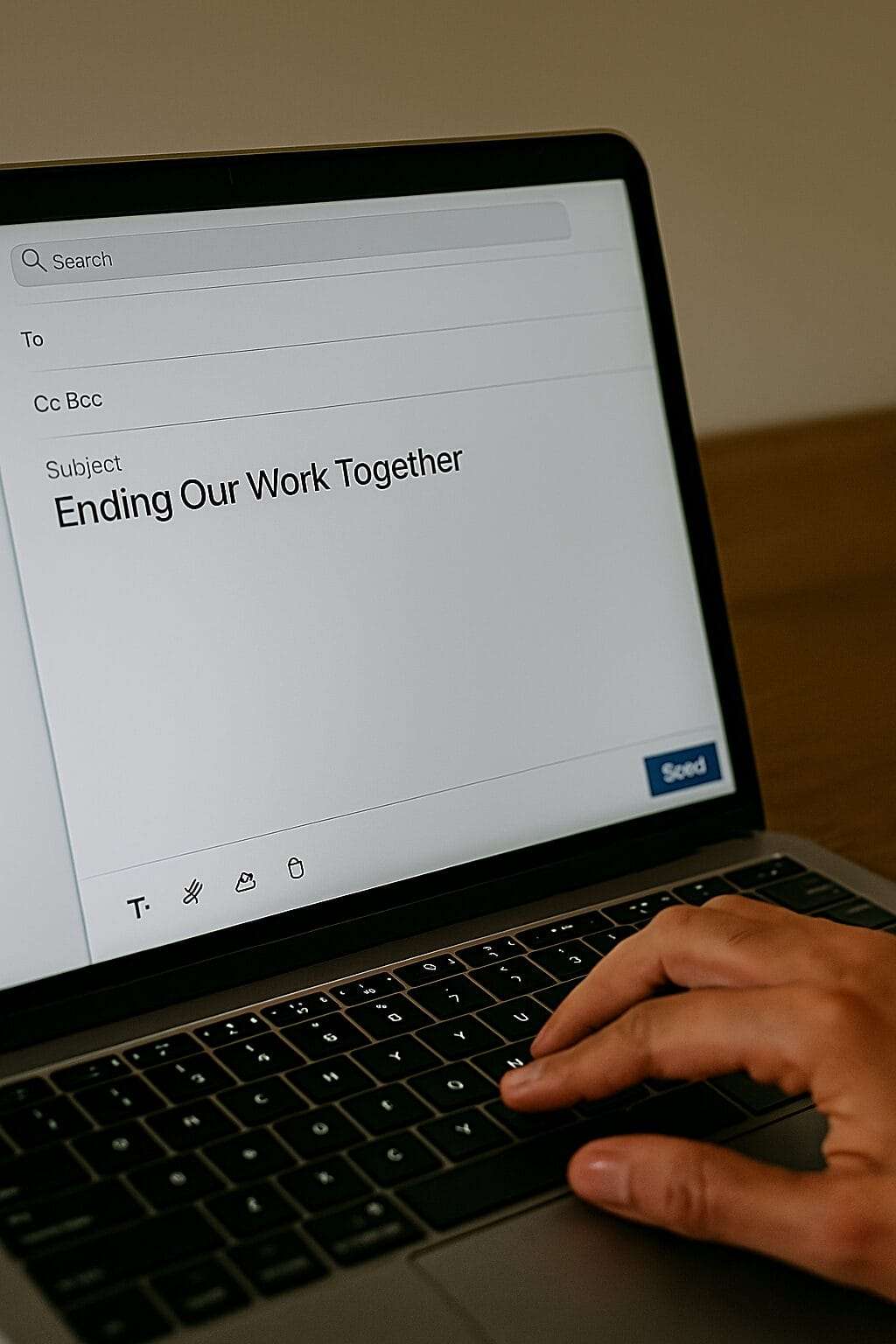
Not Every Client Is Worth the Labor: How to Handle Difficult Clients and Know When to Let Go
- Updated: June 18, 2025
You didn’t get into business to babysit grown adults.
But here you are—burning out over someone’s lack of boundaries, rewriting your contract in your head to justify their behavior, and asking yourself, “Is it me?”
Let me make it plain:
It’s not just them.
It’s not just you.
It’s the dynamic.
And it’s draining the life out of your business.
I wrote this for the leader who knows better now.
For the one who’s done spiritual cartwheels to “make it work.”
For the high-functioning professional who’s scaling—but still carrying dead weight out of habit, guilt, or performance conditioning.
This isn’t just about difficult clients.
It’s about self-abandonment disguised as professionalism.
It’s about emotional labor you were never meant to absorb.
If you’ve ever convinced yourself that you had to “earn your way up the food chain” by enduring unprepared, boundary-blurring, energy-sucking clients—this is your permission slip to stop.
Welcome to your Independence Day.
The Walkaway Blueprint
🧨 Why You Stayed Too Long
You didn’t miss the signs.
You overrode them.
You knew they were flaky when they ghosted your pre-call emails.
You felt the dread in your chest after that second Zoom call.
You saw the power struggle creeping in when they pushed your boundaries and wrapped it in praise.

But instead of walking away, you rationalized it.
“They’re probably just anxious.”
“Maybe if I just clarify again…”
“They said they’ve never felt this safe before.”
“It’s not ideal, but it’s money.”
Here’s the truth:
You didn’t stay because you were stupid.
You stayed because you were trying to be good.
A good coach. A good leader. A good business owner who doesn’t quit when things get hard.
But at some point, professionalism became performance.
And performance became self-erasure.
You didn’t just serve. You shape-shifted.
You didn’t just listen. You absorbed.
And now, instead of running your business—you’re managing their emotional weather.
Let’s be clear:
This isn’t about one bad client.
It’s about a pattern that’s been quietly training you to betray your own gut in the name of “being nice,” “being helpful,” or “being resilient.”
And if you’re here, it’s because you’re ready to stop.
🚩 Red Flags You Ignored—And Why You Did
This wasn’t a blindside.
It was a slow walk toward professional purgatory, and the signposts were everywhere.
You knew something was off—but you kept adjusting yourself instead of confronting the pattern.
Maybe you told yourself they were just “nervous.”
Maybe they flattered you with trauma-bond lines like, “I’ve never had anyone see me like this.”
Maybe you stayed because you didn’t want to seem “difficult” or “too sensitive” for walking away.
But the truth is, your body knew first.

You started double-checking your emails before hitting send.
You got quieter in your sessions—overthinking every word.
You began carrying the sessions afterward in your head, like emotional residue you couldn’t shake.
And if you’re being really honest…
-
You kept rewriting your onboarding documents in your head after every session with them.
-
You found yourself rehearsing emails to explain things you’d already explained—twice.
-
You couldn’t tell if they were manipulative or just chaotic… but either way, you were exhausted.
This isn’t about failing to spot the red flags.
You saw them.
You just didn’t believe you had the right to walk away without “proof.”
So you gave them the benefit of the doubt.
Over and over.
Until your doubt became your new standard.
But here’s the part that no one tells high performers:
The client didn’t just drain you—you trained them to.
Because every time you absorbed their drama without naming it…
Every time you made exceptions…
Every time you over-delivered just to keep the peace…
You were teaching them what you were willing to tolerate.
It wasn’t just about difficult clients.
It was about you bypassing yourself in the name of leadership.
But that ends here.
Need help exiting a situation that’s already gone too far?
👉 Read: It’s Not Boundaries—It’s Goodbye: When to Fire a Toxic Client
🩸The Hidden Cost of Carrying the Wrong Client
Let’s be honest—it’s not just your calendar they’re crowding.
It’s your clarity. Your confidence. Your conviction about why you built this in the first place.
The wrong client doesn’t just waste time.
They slowly erode your sense of purpose.
Because when you’re constantly managing someone who’s emotionally bypassing, flaky, unprepared, or deep in self-abandonment—you start to question your own process.

You catch yourself thinking:
-
“Maybe my program isn’t that clear.”
-
“Maybe I should’ve just let that slide.”
-
“Maybe I’m being too rigid.”
But it’s not that your work stopped working.
It’s that you kept bending it to fit someone who wasn’t ready for the weight of it.
And here’s the dangerous part:
Over time, that bending becomes your new normal.
You stop trusting your own structure. You start preemptively softening it to avoid conflict.
That’s not client-centered.
That’s self-erasure in leadership clothing.
“Emotional labor is the silent tax you pay when you’re working harder on their growth than they are.”
— Denise G. Lee
🔍 What the Stats Say
A 2022 study of strength & conditioning coaches and personal trainers found that 18% reported client-related burnout—burnout caused by client dynamics—on top of personal and work-related fatigue.
That’s not just annoying. That’s operational sabotage.
And if you’re building something real, you can’t afford to keep hemorrhaging focus every time a flaky client spirals, ghosts, or drags their heels until you question your methods.
You cannot scale while dragging emotional dead weight.
You can’t lead while constantly firefighting.
You can’t build legacy while babysitting.

🛑 When to Stay, When to Walk
This isn’t a checklist.
It’s not some cutesy quiz where you tally up red flags and wait for a score that gives you permission to leave.
This is about the gut punch.
That moment in your body when everything in you says:
“Hell no. I can’t do this again.”
And if you’re honest—you already know.
You’re just waiting for enough proof to justify pressing the eject button.
But let’s be real: by the time you’re asking if it’s time to walk… it probably was weeks ago.
🧠 What Staying Should Require (But Rarely Does)
If you’re considering staying with a difficult client, the only reason to do so is if:
-
They’re emotionally invested in the process and doing the work
-
You feel safe, respected, and stable in the container (even if it’s rocky)
-
The issues are circumstantial—not character-deep
-
There’s a mutual commitment to growth—not just survival
-
They’re not hijacking your energy or bleeding into other client relationships
But if you’re:
-
Bracing before every call
-
Rewriting your boundaries in your head just to avoid a blow-up
-
Finding yourself performing more than coaching
-
Or noticing your good clients are getting less of you because one client is taking up too much emotional bandwidth…
Then it’s already over.
You just haven’t made it official yet.
✨ Reminder:
Staying only makes sense when both parties are growing—not when one is constantly shrinking to maintain the illusion of harmony.
You are not a martyr.
You are not a fixer.
You are a leader.
And sometimes, the most loving thing you can do—for both of you—is to walk away clean.
🚪Exit With Integrity—Not Apology
This isn’t about sobbing your way out of the situation.
You don’t need to cry about it.
You don’t need to shapeshift to soften the blow.
You don’t need to stand in front of a mirror and chant, “I am worthy of aligned clients.”
You just need to leave.
Not for your future self.
Not because it might “get better later.”
But because your present self is already being bled dry.
And here’s the key:
You can walk out clean.

💡 The Exit Isn’t Revenge—It’s Repair
This isn’t a power move. It’s a clarity move.
You’re not trying to punish the client.
You’re protecting the container.
For them. For you. For everyone else who deserves your full presence.
📄 What Grace Looks Like in Practice
-
Be clear.
No vague “we’re going in different directions.” Say what’s not working. -
Be brief.
Over-explaining invites negotiation. Don’t argue your peace. -
Be generous (but boundaried).
Offer a graceful off-ramp: a wrap-up call, a short resource list, or referral only if it feels clean. -
Document everything.
A written summary of your closure terms protects you emotionally and logistically. -
Close the loop.
Don’t leave the door ajar. Exit with finality—not flirtation.
And no—you don’t have to hold space for their reaction.
They might spiral. They might stonewall.
But you’re not their therapist. You’re not their regulator.
Your job is to exit the dynamic, not carry it on your back one more mile.
This is leadership—not a spiritual performance.
🧭 You Weren’t Wrong. You’re Just Done.
You didn’t fail.
You didn’t attract the wrong client because you were “out of alignment” or “in a low vibe.”
You just stayed too long in a dynamic you already outgrew.
That’s not weakness.
That’s what most high-functioning, emotionally intelligent people do—especially when we’re trying to prove we’re worthy of being trusted, chosen, or respected.

But here’s the truth:
You don’t have to earn your way out of exhaustion.
You don’t need permission to choose peace.
You’re not required to suffer in order to be seen as strong.
You were doing the best you could with the tools you had.
And now that you have better tools—like discernment, clarity, and self-trust—you get to use them.
It doesn’t mean you were wrong.
It just means you’re done.
Let them think you gave up too soon.
Let them wonder if they were the reason.
You’re not here to correct the narrative—
You’re here to protect your peace.
– Denise G. Lee
So close the loop.
Exit clean.
And don’t look back unless it’s to remember how far you’ve come.
🪨 Final Thoughts: Cling to You—Not Dysfunction.
You’re allowed to outgrow what once felt like a win.
Just because you worked hard to land the client doesn’t mean you have to keep performing for them. Just because you poured yourself into the container doesn’t mean you owe them your energy forever.
Let this be your reminder:
You can care deeply and walk away clean.
You can lead with grace and hold the line.
You can let go without apology.
Not every client is meant to stay.
And that doesn’t make you a quitter.
It makes you a leader.
Ready to go deeper?
If you’re done sacrificing your clarity for someone else’s comfort—
I’d be honored to support you.
💛 Work with me, Denise G. Lee – Together, we’ll clean up the emotional residue of past client dynamics, build a business rooted in clarity, and create a system that protects your peace.
👉 Explore coaching options
🎙️ Need more grounded leadership talk like this?
Listen to my podcast for raw conversations on boundaries, emotional labor, and building a business without self-betrayal.
👉 The Introverted Entrepreneur Podcast
💌 Been here before?
Tell me your story. I’d love to know how you navigated a hard client exit—or what you’re still wrestling with.
👉 Write me a note





